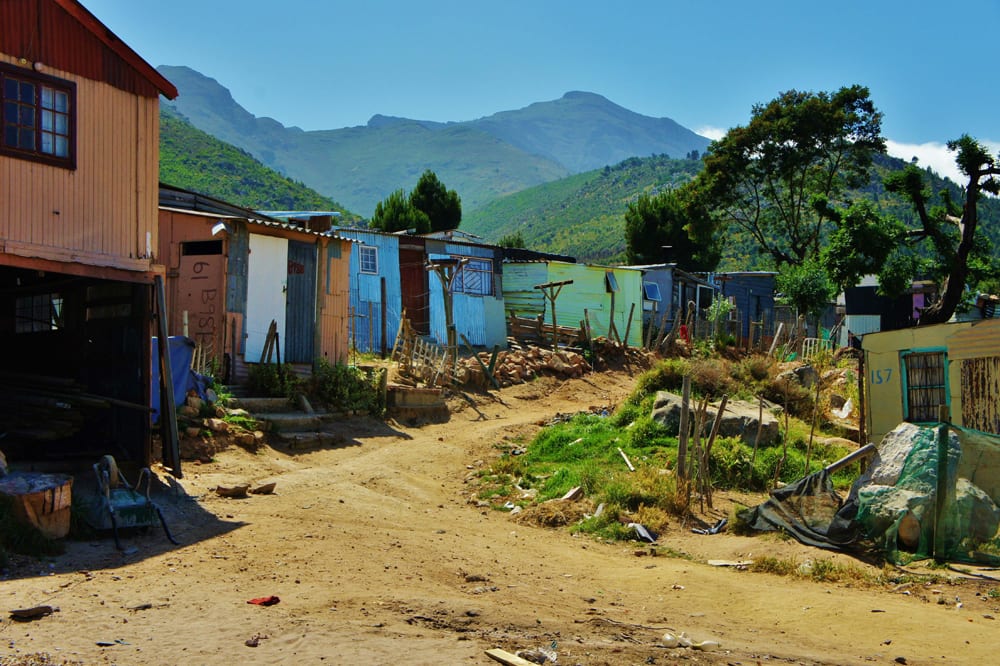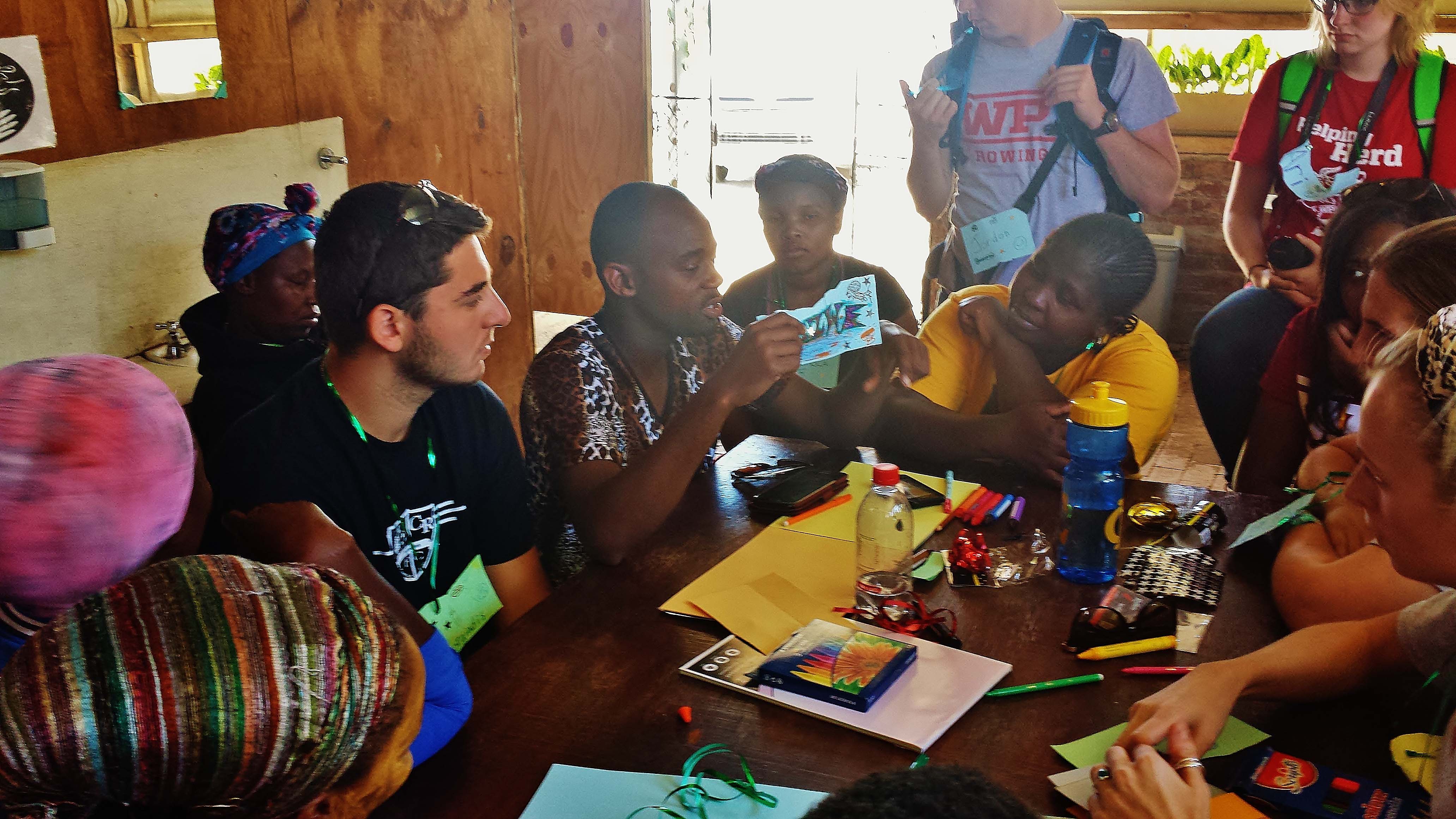Act 1 Scene 1
Our First Days
Setting
The Langrug Community
After an hour drive out of Cape Town, through vineyards and towns, we arrive in the Municipality of Stellenbosch. Langrug, the informal settlement in which we will be working for the next seven weeks, is situated behind a more structured, formal community along the base of a beautiful mountain range. With an approximate population of 4000 people, Langrug is densely organized with shack houses and spaza shops, along with other various businesses such as hair salons and shoe repair shops.
Backstory
Our project will be centralized in the Langrug community, an informal settlement in the Municipality of Stellenbosch. Throughout 2012 and 2013, past WPI project groups both established and assessed a Water, Sanitation, and Hygiene (WaSH) Facility meant to aid the community in health, education, and well-being. Our sponsor, the Community Organisation Resource Centre (CORC), will be aiding us throughout the process, with the help of our advisors, Scott Jiusto and Steve McCauley.
Cast of Characters
Our first day in Langrug was filled entirely with introductions of the leaders in the Langrug Community and CORC Representatives, including:
- Sizwe Mxobo: CORC representative and group translator
- Tondaka: CORC representative. Tondaka works on sustainable livelihoods in CORC
- Caretakers: Mama Poto and Mama Nomthandazo. These two women, along with one other, maintain the facility, manage the usage, and keep records when necessary.
- Community Leaders: Nobathembu, Kholeka, Vuyelwa, Noluisindiso, Zodwa, Amanda, and Noloyiso. These ladies are helping construct the new WaSH-UP Facility in Zwelitsha and are leaders within the Langrug community.
- Alfred: Vice Chairman of Langrug. He has been more involved with the community recently.
- Trevor: Chairman of Langrug. He has been working less with the community hands on.
- Chuma: Works with CORC and in the Langrug community
- WaSH-Serv: Nathan George, Danielle Haley, Mollie Myers, and Heather Ullery
- WaSH-Biz: Nicole Baker, Stephanie Esmond, Kostantinos Georgiadis, and Reed Gontarek
Fortunately we were also able to meet and interact with:
- Andrew: member of Touching the Earth Lightly who is assisting in the construction of the Zwelitsha facility
- Father George: An 84 year-old Argentinian architect who has been working in the community after living in Japan for 60 years
Scene
Initial Observations of Langrug
After driving through vineyards and towns established in the valley of the beautiful South African mountains of Stellenbosch, we are taken aback to enter Langrug, an informal settlement slightly off the highway. Immediately the paved road becomes dirt and we notice the difference between the structured towns and cities and the informal settlements and conversation in the van immediately drops off. A group of community members performing construction watch us as we slowly enter Langrug. Sizwe informs us that there is construction happening on the water mains to reform the way water travels through the community. We head up a steep narrow path that leads to the Mandela Park Facility with shack houses lining either side. Laundry is out air drying, grey water sits in pools and travels in small streams littered with trash in some spots, and children walk through the streets, sometimes without shoes or clean clothing, while stray dogs and goats wander and eat trash. Shack houses are made of a variety of materials, such as hard plastic, metal, garbage bags, and tires, in different shapes and sizes. We notice that some have electricity and we hear familiar American songs on the radios. All the while, gorgeous mountain ranges surround the community, covered in vineyards and small townships. The extreme difference between the harsh reality of Langrug and the natural beauty of the scenery provides a bizarre juxtaposition. After a short time, we arrive at the Mandela Park Facility which was situated between multiple shack houses.
WaSH Facility
The facility is located part way up the hill Langrug sits on. It is set back from the nearest road by approximately the length of one parking space, which is where the van parks to drop us off. From the outside the facility appears smaller than it did in pictures. The windows in the front and on one side are lined with gardening tubes holding spinach. On the inside, directly to the right is the caretaker’s office. Next to the office is the salon, run by a woman who often brings her young son with her. Along the same wall, past the salon and the office is hand washing sinks, with soap dispensers and mirrors. Behind the sink are is the men’s toilets and showers. The back wall has women’s toilets and showers. On the left side of the back wall are the handicapped toilet and two toilets for children. Immediately to the left of the entrance are four laundry basins. In the center of the facility is a small picnic table, along with two benches for the laundry basins. Currently the facility is closed due to construction on a water main further down the hill. The water is expected to return in the next few days. The smell of stagnant water is especially strong due to the lack of running water.
Introductions
After arriving at the WaSH facility, we walk up the hill to see the on-going construction of the new WaSH facility in Zwelitsha. We meet with several members of the Savings group, along with Tondaka, Andrew T, and Father George. The members of the Savings Group, many of whom are women, are physically working on building the frame for the facility when we first arrive. After learning some basic Xhosa, we say our names and explain our majors, as some community members are interested in learning more about us. This conversation is notable because we have to explain our very specific interests and majors in simpler terms so they can be translated. Our discussion also included our family, interests, and elementary descriptions of potential plans for Langrug. There was some difficulty with translation from English to Xhosa but an understanding of each other’s families and areas of study was established. The community leaders presented their hopes for the WaSH teams to dedicate some thought and time toward exploring an area for garbage disposal, expansion of electrical services, and some issues with the Zwelitsha facility, while keeping our services and business strategies in mind. We are hoping that future conversations will help us prioritize needs and services. Before leaving, we play catch with some neighborhood kids which jumpstarts a friendship with them. We observe that they are playing with rocks, condoms, and razor blades. We hope to educate the parents about why these “toys” might be unsafe for them.
Getting to Know You- Day 2
On Day Two, the Big Issue team joins the WaSH-UP Business team and WaSH-UP Services team to travel to Langrug. Big Issue needs to shoot material for their Laurie Leshin Inauguration Video and asks the WaSH teams for their assistance in doing this in Langrug. Scott and Steve join community leaders, Sizwe, and the student groups in walking up to the Zwelitsha Facility. Upon returning back down to the Mandela Park WaSH facility, the WaSH teams set up benches around the picnic table and take out the crafting materials they had purchased. They ask everyone to create nametags that include pictorial representations of individual interests and favorite things. The WaSH teams, Big Issue team, Sizwe, and about ten leading community members take part in the activity. After everyone finishes, individuals share their names, the pronunciation of their names, and what the pictures they drew symbolize. The community members and Sizwe get a real kick out of the teams’ attempts at pronouncing Xhosa names. Through the sharing of drawings, all groups exchanged much information. When Mollie and Reed draw rugby balls on their nametags due to their love for the game, community members express their desire to learn how to play. The groups decide they will get a rugby ball and teach each other how to play. Nadjia draws a heart on her nametag and shares the importance of familial and companion love, in addition to romantic love. After this, many community members share their experiences with love and subsequently, their current views on the matter. Some people draw cats and other animals to represent their pets and the community members share the superstitions that accompany many of these animals in their culture. Sizwe is a facilitator of the activity and asks follow-up questions to many people’s explanations of what is important to them. His constant asking of “why?” encourages everyone to delve deeper and really open up. Recurring themes are love and family and we all decide that a connecting factor, our shared humanity, causes more similarities than differences with one another.
Reflection
After spending two days with the Langrug Community, we are excited to continue getting to know the community members and start working in the WaSH facilities. Our first day brought about overwhelming feelings but the community’s warm welcome left us feeling reassured about our purpose in Langrug. The community members mentioned they were looking forward to our arrival all year. Although some people were shy at first, our name tag exercise helped everyone to feel connected and open with one another. It was difficult seeing the living conditions of Langrug, but it was encouraging to witness the energy, enthusiasm, and positive outlook of the community members. A big challenge we see in the future will be embracing the struggles of those we work with, but not allowing their pain to incapacitate us. Sizwe made a point of telling us to “feel” their pain, but not to “carry” their pain. Overall we are excited to continue building relationships based on sharing, learning, and growth, as well as working together to expand the services of the facility in the Langrug community.




